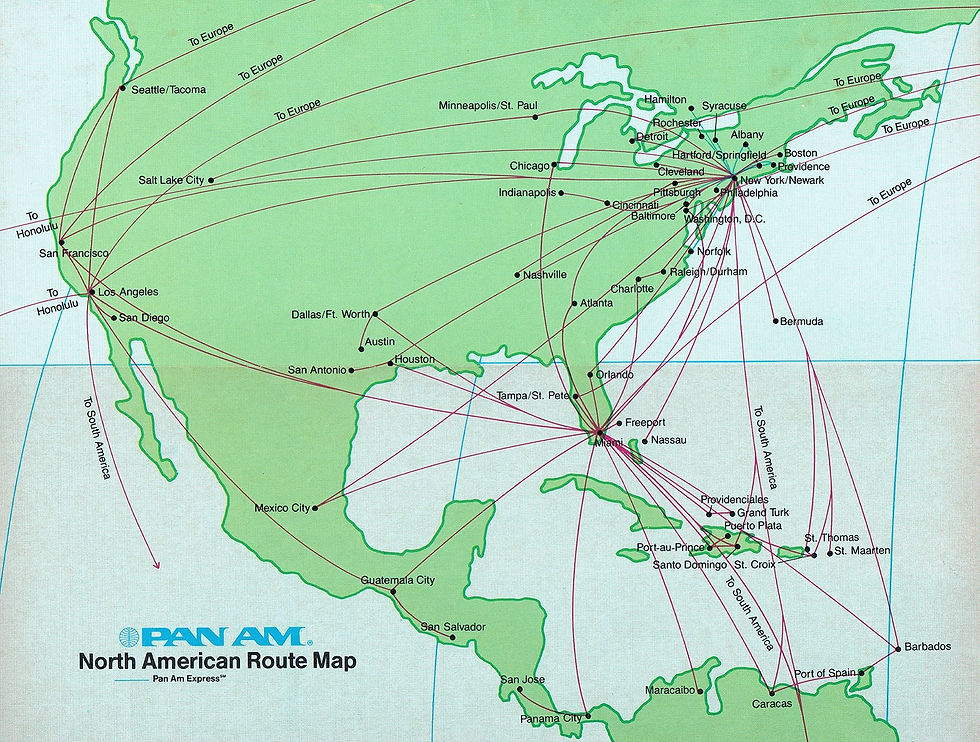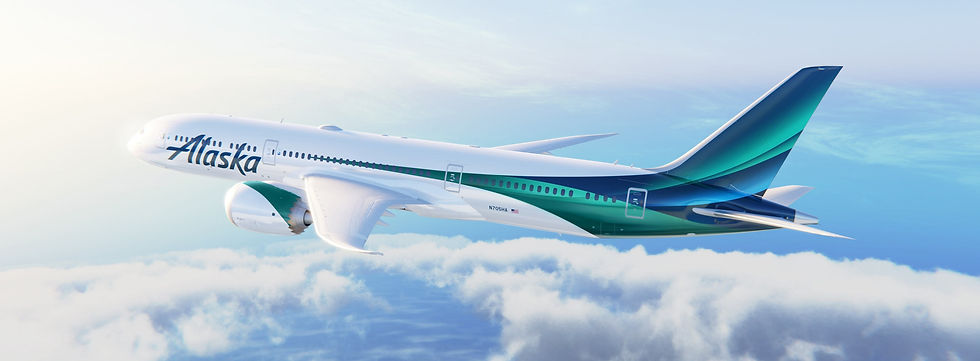You Can't Beat The Resurrection...Again
- George Nicon Andritsakis

- Oct 16
- 7 min read

"What could go wrong, did. No one who followed Juan Trippe had the foresight to do something strongly positive … it was the most astonishing example of Murphy's Law in extremis. The sale of Pan Am's profitable parts was inevitable to the company's destruction. There were not enough pieces to build on."
Stanley Gewirtz, former Pan Am Vice President for External Affairs
For most of its storied history, it was known as The Chosen Instrument, it's logo 2nd in popularity and recognition next to the Coca-Cola logo, it was the airline that brought the Beatles to the United States for their first tour, it inaugurated the Jet Age with the introduction of the Boeing 707, shrunk the world as the launch customer of the Boeing 747, the first airline to bilk customers for down payments to the Moon, called itself the "Most Experienced Airline In The World", and one of the first U.S. carriers to fly the Airbus A300 and the first U.S. carrier to fly the passenger variant of the Airbus A310. It was the most recognized airline brand in the world, for better or worse, and that undoubtedly also made it one of the most targeted airlines as well. I can only be speaking of the well documented and reported on Pan American World Airways, which lasted from 1927 to 1991, itself the victim of its own hubris, ego, inept management, and a long list of bad decision after bad decision, and several very public and very high profile terrorist attacks.

It was resurrected 5 years later with a small fleet of Airbus A300's and Boeing 727's and 737's but filed bankruptcy 2 years later after a terrible merger with Carnival Air Lines. The third iteration took off in 1999, with a fleet of Boeing 727's and a business plan that linked their base of Portsmouth, New Hampshire, with secondary airports (like what Allegiant, Avelo, and Breeze do now). That miniscule operation folded its wings in 2004.
Starting a new airline operation with the name and branding of a previous airline has historically been a disastrous idea that only lasts a short while before said carrier eventually shuts down. You can only go so far just on name recognition and history alone. The only airline that has managed to be the exception so far is Frontier Airlines, itself having its own troubles in the late 2000's until it transformed itself into the ULCC (Ultra Low-Cost Carrier) it is now.
Now, after just over 2 decades gone, Pan American Global Holdings (the trademark holder) is teaming up with merchant bank and aviation consulting firm AVi8 Air Capital to resurrect the name and brand into a whole new U.S. scheduled airline. They have announced they will operate Airbus aircraft (Spirit just so happens to have shed almost a hundred Airbus narrowbodies from their fleet recently) out of their base in Miami, Florida. Who will actually helm the airline and run it is still unclear, but at this point, AVi8 has stated that they've finished their comprehensive business plan for the new startup and are now beginning the certification process with the Federal Aviation Administration (FAA) and Department of Transportation (DOT) to establish Pan Am as a Part 121 scheduled carrier.

Now step back in time, to around 1991, when Delta Air Lines took what was left of the original Pan Am's carcass, the Trans-Atlantic division, the Frankfurt hub (access to London Heathrow was sold to United Airlines the year before), the Northeast Shuttle (which made no sense in the original Pan Am's system), and the fleet of A310's. Delta agreed to furnish funding to what was left of Pan Am to keep flying out of Miami to Caribbean and South American destinations, using what was left of the fleet, the ageing, decrepit Boeing 727's and 747's, and the Airbus A300's, effectively making it return to its roots, albeit still burning through millions of dollars per day. Delta pulled the plug on that money pit as soon as it could and Pan Am should've died right then and there.
Will this Pan Am be different than the other iterations? Maybe, maybe not. AVi8 is run by competent executives who've turned around several airlines (Cayman Airways), started others from scratch (jetBlue Airways, Global Crossing), and even brought back to life the name of Eastern Airlines, which runs charter and deportation flights with Boeing 767-300's and 777-200's. It also managed the New England Patriots Football Team's flights for a while.
Their pick of Miami as the main hub is definitely based on history, as well as a huge population catchment area, however, American Airlines has been fully entrenched at MIA since the collapse of both Eastern and Pan Am, and now controls a healthy 60% of the market, with some 31 million passengers flying in and out of, or through, Miami. That alone is a tough cookie to break, let alone the scores of other carriers that have multiple flights daily in and out. For what the carrier has planned though, Caribbean, and Latin destinations, MIA does work well, and if there's enough gate space, they can definitely make some waves. American, however, can dump capacity into MIA onto those routes where Pan Am launches. They've done it before to run annoying competitors out (think Legend Airlines out of Dallas/Love, Texas) and might not hesitate to do the same in one of their fortress hubs. They have scores of corporate contracts in the area, not to mention passengers who are tied in by the AAdvantage Frequent Flyer Program and associated credit cards attached to it.

One of the biggest problems the original Pan Am had post-deregulation was that it had no real effective domestic feed to its hubs. You take a look at their route maps after their merger with National Airlines, and you'll see huge chunks of the United States that have no service. The route map that National had pre-deregulation and pre-merger largely stayed intact. It wasn't until 1985-1986 that you'd see Pan Am make any sort of new domestic expansion, with the Pan Am Shuttle out of New York's LaGuardia, and into places like Minneapolis, Kansas City, Salt Lake City, or Nashville. New York/JFK got the majority of the feed, and Miami getting a few extra lines here and there, but once the Pacific was sold to United Airlines in 1985, the San Francisco base went with the deal, and the beleaguered carrier was down to just San Diego, Los Angeles, San Francisco (as a spoke with a few routes heading East), Honolulu, and Seattle, where it still had a flight to London to feed. Feeble attempts at having regional commuter airlines provided Pan Am Express branded flights out of New York/JFK and Los Angeles, and a bit out of Miami too, by 1989, but it was all for naught. The airline just couldn’t continue like that.
I hope this new Pan Am won't have those same issues, and is smart by only announcing one base at this time, hopefully, it can carve out a niche for itself in Miami, even if it is a narrowbody, steel drum island hopping operation. Better to build up the fleet and domestic feed and then head out over the waters of the Caribbean, they'll stand a much better chance against American and the other carriers in the region.

The fleet is also a good pick. There's plenty of Airbus narrowbodies available, especially with Spirit Airlines dumping almost a hundred of them to save themselves during this second trip through the bankruptcy courts. The media covering this new startup seem to forget the original Pan Am flew the Airbus A300 and was the first US operator of the A310. The A320's and A321's have good range, great economics, and most every airline uses them nowadays. If they are of the NEO versions though, I hope there's enough powerplants to go by to power these things instead of having the fleet sit idle in MIA's cockroach corner, waiting for engines that Pratt & Whitney just can't seem to fix fast enough. But hey, Pan Am was known for ordering planes with powerplant problems, remember the Boeing 747's engines chewing up fan blades, compressor stalls, and engine casing distortions? Hey, that was another Pratt foul up. Enough about the incompetence of Pratt & Whitney. The Airbuses are fantastic airplanes, and the fleet sounds like it will be good, hopefully with the right mix of A320's and A321's, as I stated above.

Pan Am Global Holdings has kept the brand alive, by licensing it out to all corners of the globe, you can find Pan Am replica bags in gift shops in airports, stores in Asia, shirts with dozens of Pan Am logos and old school advertising on them even at places like Target. There's even a Pan Am board game. Oh, and who can forget that truly awful Pan Am TV show from about a decade back? Don't get me wrong here, I don't hate Pan Am. I do think the brand is seriously eroded and watered down, to me, it's almost exactly like what the rock band KISS did with merchandising. Licensing their name and likeness out to anyone who'd cough up the dough. KISS even had a KISS casket for sale! Let's hope with this new startup all the Pan Am emblazoned merchandise will be scaled back to more normal things, like, model airplanes of the great fleet, or clothing, books, etc. Keep the history alive, yes, don't turn it into a circus.
In closing, I'm just going to say I wish the new Pan Am all the success in the world that was once its playground. Let's hope it gets a chance to stay on the swing set longer this time, with far better management and more solid management. It's going to have a huge hill to climb in Miami if it takes on American Airlines, but with the right strategies, discipline, and adaptability, it should do well. It's definitely piqued my interest, even though I'm so over new airline startups trying to use the name and trademarks of past airlines. That being said, good luck to them and all involved. Maybe we'll see the return of the Sky Gods...








Comments